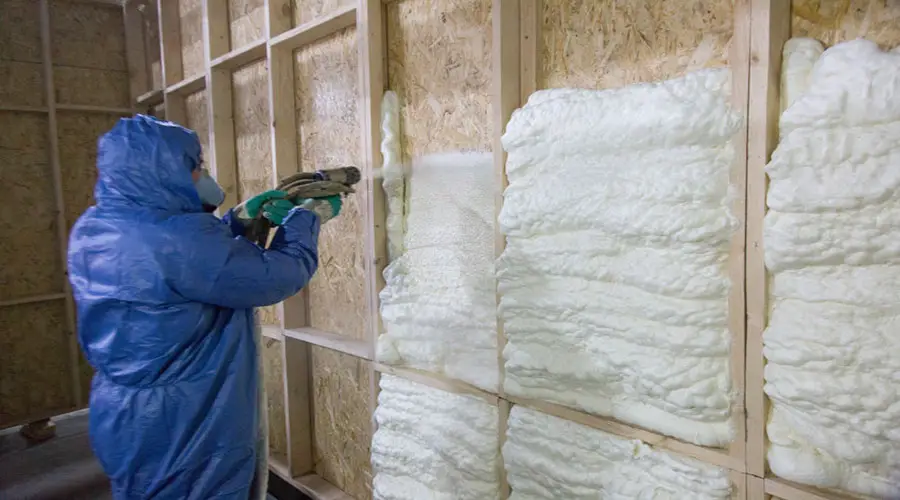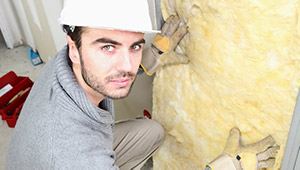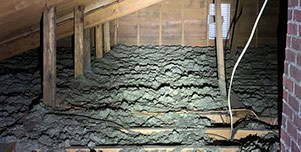
A home that’s too hot or cold during weather extremes can be a homeowner’s worst nightmare. Homeowners find ways of weatherproofing their homes to make sure they are as comfortable as possible every time. Spray foam insulation is an efficient way of making sure your home has the proper interior temperature all year round. However, sometimes, it comes with problems.
Spray foam insulation sometimes goes wrong, and it leads to problems that might need massive overhauls. Common problems with spray foam insulation include:
- Superheating in a closed area
- Roof damage
- Hidden termite damage
- Permanent foul smells
- Mold and mildew
- Health complications
Fortunately, these are avoidable problems if your contractor has a keen eye for clean results. This article should put your spray foam insulation fears to rest. If you have a new home or an older home and want to insulate your home with spray foam, you can avoid these problems.
What Causes Spray Foam Insulation Problems
Spray foam insulation has been an easy choice for homeowners looking to make their homes comfortable. Still, there are calls made to contractors to fix spray foam insulation messes.
Most problems with spray foam insulation stem from three things.
- Application errors
- Homeowner error
- Uninformed expectations
Application Errors
Application errors can increase heating and cooling expenses for the homeowner. Additionally, they will have to think about the cost of repair, which in severe cases means a take-down of the insulation at huge expenses.
The first application error is using unbalanced spray foam. Now, this might not be on the contractor side. The contractor might have mistakenly got a poorly balanced batch. The unbalanced batch can envelop the home in a permanent foul odor. In other cases, the spray foam won’t adhere to the surface.
To curb this balancing problem, a professional spray foam insulation expert makes sure the chemicals mixed for the insulation meet the required ratios to meet standards.
Sometimes the contractor gets the right balance of chemicals. All their equipment is up to code too. However, a bad day at the office means they leave sections of the house poorly insulated.
When dealing with a product that cures as fast as spray foam, you have little room for error. You need to be precise to make sure you cover every crevice.
The incorrect application leaves crevices unfilled or some sections sealed too tight. Underspraying exposes your home to external cold air during winters and unbearable hot air in the summer. Overspraying means you have unbalanced areas that might expand during summer and ruin sections of the home.
Homeowner Error
Consumer error leads to the third cause of spray foam insulation problems.
Homeowner error is primarily a problem with due diligence. When you contact a professional about insulation, you need to take time and ask them about their product and service. That way, you know their expertise level. Otherwise, you expose yourself to the risk of lousy spray foam insulation and possible home damage.
Unmet Expectations
Why do you want to insulate your home? You might be insulating to reduce energy bills, keep out external sounds, or make a space more livable. You need to communicate clearly your expectations to the contractor.
Your objectives for the insulation will determine what rooms they can cover and what type of insulation they will apply.
Common Spray Foam Insulation Problems
Here are common spray foam insulation problems you may face.
Superheating
Spray foam insulation can improve your attic and garage’s heating to normal home levels even when it’s scorching outside. However, you can turn your home into a hot mess if you use the wrong foam. Closed-cell foam insulation locks in heat. It doesn’t allow much circulation.
A well-insulated house needs circulation beneath and above the insulation. Closed-cell foam insulation retains heat from the source. When the home can’t dissipate the heat outward, your HVAC system has to work extra hard to regulate internal temperature. Areas such as attics experience high temperatures in summer because of their proximity to the roof.
The trapped heat in attics expands. The expansion affects the structural integrity of the roof. Over time, constant expansion and contraction weakens the shingles and makes room for air pockets in the shingles. At this point, it’s only a matter of time before you see roof damage.
To correct the problem, you need to use breathable spray foam insulation such as open-cell insulation.
Roof Damage
Trapped heat in attics can ruin your roof. But did you also know spray foam insulation can lead to wood rot in the roof? It might be rare, but it’s a possibility even when the insulation is correct.
If your roof had prior damage outside, water from the rain seeps in. The water cannot evaporate since it gets trapped in the insulation.
As the insulation keeps soaking up more water, heat pushes the condensed water into the wood truss. Over time, the condensate saturates the rafter and wood truss.
Fortunately, this problem occurs during the rainy and cold seasons. Also, sealing any entry points on the roof can solve the problem. The insulation also needs to be breathable so the water can move through the insulation and evaporate.
Hiding Termites In The Sills And Joists
Termite damage is an indication of poor application of the spray foam. Houses need occasional inspections to make sure everything is in good condition. However, it can be hard to see some hidden areas if an insulation contractor covered part of the house from being visible during inspection.
Sills and joists are vulnerable to termite damage, especially in dry areas. It would take a thorough look to notice any termite infestation.
Permanent Foul Smells
Foul smell is one of the biggest problems with improper spray foam insulation. Some homeowners don’t know what they’re getting when they hire a contractor. Take, for instance, this case of a couple who had to evacuate their house for months after they had their home sprayed. Usually, a foul odor is an indication of bad ratio mixing or bad chemicals in the foam. Spray foam is prepared on the job site, as opposed to in a factory.
There would be better quality control standards if the foam were pre-mixed in a central place. The solution to avoid bad odors would be to test out a small area. Due diligence also applies here. Find out the expertise of the contractor to reduce the chances of working with an amateur.
Mold And Mildew
Non-adhesion is a common problem in spray foam insulation. Bad chemicals and improper mixing of the chemicals causes cause non-adhesion. When it doesn’t adhere to the surface, spray foam leaves cavities that seal in water and provide grounds for unfettered growth of mold and mildew in damp spaces such as the basement and attic.
Like in most of the problems, the right contractor makes sure they have the correct spray foam. It’ll be well mixed, and all the spaces will be covered entirely.
Health Complications
You need to be extra vigilant when you’re working with chemicals in your home. Chemical imbalance can cause the isocyanates to react with the body.
Isocyanates carry carcinogenic properties that expose you to asthma, lung damage, skin irritation, and gastrointestinal issues.
This is one of the main reasons why the CDC vouch for proper ventilation.
How Can You Tell If Spray Foam Insulation Is Bad?
As the homeowner, it’s on you to know if the spray foam insulation is good enough for your home and health.
There are some quick ways to tell if you are paying for a good job or you’re getting shortchanged.
The Spray Foam Doesn’t Adhere To The Substrate.
Both open-cell and closed-cell spray foam insulation stick and expand on the surface when they are in contact.
If you notice that a section of the insulation pulls away from the edges after spraying, there are two possible problems. The spray foam mixture is bad, or the substrate is wet.
The Spray Foam Stinks
Bad mixing leads to an imbalance, causing the end product to stink up the home. As mentioned, contractors get spray foam in unmixed form. They have to balance it on the job site before applying.
Another cause of stinky spray foam is poorly ventilated space. Spray foam mixing and off-gassing give off heat. You have to pre-ventilate your home to avoid the concentration of foul odor in your home. In extreme circumstances, it becomes permanent.
Uneven Appearance
Inconsistency in appearance can manifest itself in color or bubbles. Spray foam curing is an exothermic reaction.
Allow time for the spray foam to dry before spraying a second line. It doesn’t take much time. However, the installer got the chemical ratio wrong if you notice the color change from green to yellow to a toffee hue.
Hack To Identify Improper Spray Foam Installation
Any spray foam insulation professional will tell you sometimes you miss a spot. If the missed spot is left unchecked, it will cause huge problems later. It will cost you extra or put you out of your house for a while. To avoid this, here’s a neat trick.
- Fog machines typically pressurize a space. Insulation, for contrast, depressurizes a room. Fog machines blow air inwards.
- To create a pressure balance, some of the fog will be pushed outwards through any leaks. There needs to be a second person outside observing the fog. That way, the installer will know where to patch up.
What Are The Disadvantages Of Spray Foam Insulation?
It Needs Professional Application
At surface level, spray foam insulation looks easy. It’s not. The installer must know chemical science and how to ratio the ingredients to get the right consistency for the foam. They must also know the basics of house layouts so they don’t miss sections or cover sensitive spots like wire channels and electrical outlets.
Undoing Spray Foam Insulation Is Expensive
Spray foam insulation damage is not immediately noticeable in some cases. Issues such as pressure build-up and wood rot can thrive for long without a homeowner noticing. It becomes expensive to repair insulation damage when it’s too late. For example, if pressure changes damage the roof or get a bad odor, you might need to undo an entire section of the house. It costs money, time, and peace of mind.
It Can Lead To Health Complications
The health risks associated with spray foam insulation are one of its most underrated disadvantages. Spray foam contains a class of chemicals called isocyanates. According to OSHA, long-term exposure to the chemicals used in spray foam can cause lung irritation, skin irritation, and respiratory issues.
Does Spray Foam Insulation Deteriorate?
Spray foam insulation deteriorates IF it is not well installed. However, high-quality, well-balanced spray foam insulation can last for as long as the house stands.
These factors can speed up your spray foam insulation’s deterioration.
- Punctures in the insulation can create gaps that cause the foam to expand and contract. The erratic expansion and contraction will make the insulation peel from the substrate and create uneven surfaces. Blank spaces are also prime areas for mildew growth.
- Roof leaks cause water retention in the spray foam insulation. The hidden water damage provides an environment for mold to thrive. It also eats away at the spray foam.
- Unclean substrates are a significant contributor to spray foam deterioration. If the spray foam didn’t adhere correctly to the substrate, you’d have to tear down entire sections of the deteriorated insulation to redo that area.
- Spray foam releases gases and lets in gases. Though it might be slow, this release and intake of gases lead to a drop in the R-value of the foam insulation. If the insulation is done correctly, it takes years, with the industry-standard starting from 15 years to 70 years.
What Is The Life Expectancy Of Spray Foam Insulation?
Spray foam insulation is a long-term solution. You’re looking at an expected lifespan from 10 years to 80 years. For a new home, these are good numbers if it’s a first-time installation. However, you need to check your home’s history if it comes with insulation. Older homes will likely need a re-application or a touch-up in some sections.
Most manufacturers offer a lifetime warranty on their spray foam. Check with your installer whether the foam they use is under warranty. Also, ask for their policy on warranty if you have a problem with the installation.
In Closing
There’s a saying among spray foam insulation professionals. “Hire the installer. Not the spray foam or the manufacturer.”
A spray foam insulation professional knows the correct ratios, the right chemicals, and the proper methods to make your insulation last for years”. Proper insulation will reduce your energy costs by up to 20%. However, a bad insulation job can make your home inhabitable. You can avoid all the downsides of spray foam installation by making the right call to the right professional.




